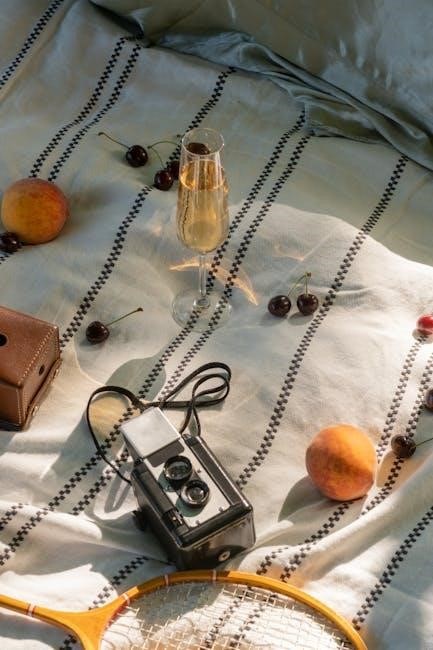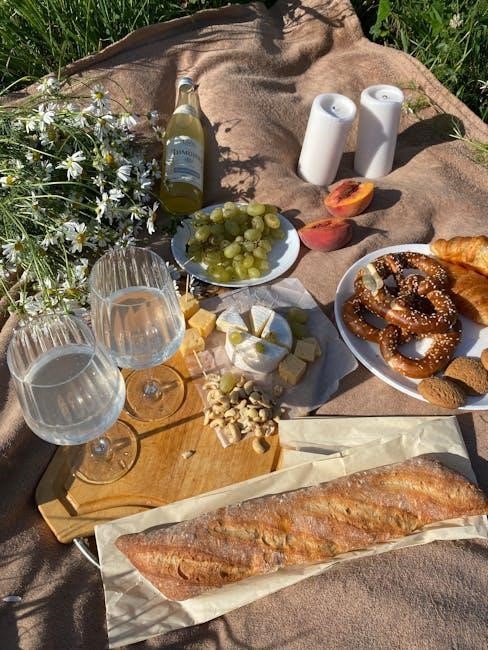Wine is a traditional‚ globally enjoyed beverage made from fermented grapes‚ offering rich cultural‚ social‚ and culinary experiences. Exploring wine can seem overwhelming‚ but with a beginner’s guide‚ you’ll discover its basics‚ from types and tasting to pairing and more‚ helping you navigate the world of wine with confidence and curiosity.
What is Wine?
Wine is a fermented beverage made from grape juice‚ offering a wide variety of styles‚ including red‚ white‚ sparkling‚ and rosé. Its flavor is shaped by grape variety‚ terroir‚ and winemaking techniques‚ ranging from sweet to dry. A popular choice for meals and celebrations‚ wine is enjoyed globally for its complexity and versatility.
Why Learn About Wine?
Learning about wine enhances your dining experiences‚ broadens your cultural understanding‚ and strengthens social interactions. It helps you make informed choices in stores and restaurants‚ discover personal preferences‚ and explore new flavors. Understanding wine basics can also transform it into a lifelong hobby‚ offering endless opportunities for growth and enjoyment in the culinary world.

Understanding Wine Types
Wine is categorized into red‚ white‚ sparkling‚ and rosé‚ each with unique characteristics. These types vary by grape variety‚ region‚ and winemaking methods‚ offering diverse flavor profiles for every palate.
Red Wines
Red wines are known for their bold flavors and rich textures‚ typically aged in oak barrels to enhance complexity. Popular varieties include Cabernet Sauvignon‚ Merlot‚ and Pinot Noir‚ offering flavors of dark fruits‚ spices‚ and earthy notes. They pair well with red meats‚ game‚ and robust cheeses‚ making them a versatile choice for many occasions.
White Wines
White wines are crisp and refreshing‚ often showcasing citrus‚ floral‚ or fruity notes. Popular varieties include Chardonnay‚ Sauvignon Blanc‚ and Pinot Grigio. They are typically lighter-bodied and pair well with seafood‚ salads‚ and poultry. Many white wines are aged briefly‚ preserving their vibrant acidity and youthful flavors‚ making them ideal for everyday drinking or casual gatherings.
Sparkling Wines
Sparkling wines are festive and vibrant‚ characterized by their effervescence. Popular types include Champagne‚ Prosecco‚ and Cava. They often feature floral‚ fruity‚ or toasty notes‚ depending on the grapes and production methods. Sparkling wines are perfect for celebrations or pairing with delicate dishes like seafood or desserts‚ offering a refreshing and celebratory drinking experience for any occasion.
Rosé Wines
Rosé wines are known for their pink hue and refreshing taste. Made by lightly fermenting red grapes‚ they range from dry to sweet. Rosés are ideal for warm weather‚ pairing well with light dishes like salads‚ seafood‚ and cheeses. Their fruity and floral notes make them a popular choice for casual sipping or social gatherings‚ offering a balanced and crisp experience.

Basic Wine Terminology
Understanding basic wine terms like tannins‚ acidity‚ body‚ bouquet‚ and finish will enhance your appreciation and help you describe wines confidently. These fundamentals are essential for any wine journey.
Key Terms to Know
Mastering basic wine terminology is essential for beginners. Terms like tannins (drying sensation)‚ acidity (sharpness)‚ and body (light to full) describe wine characteristics. Bouquet refers to aroma‚ while finish is the aftertaste. Understanding these terms helps communicate preferences and enhances your wine journey. They provide a foundation for discussing wines effectively and confidently.
Understanding Wine Labels
Wine labels provide essential information to guide your selection. Key details include the region (where grapes were grown)‚ grape variety (e.g.‚ Chardonnay‚ Cabernet Sauvignon)‚ vintage (harvest year)‚ and alcohol content. Terms like sulfites indicate allergens‚ while producer and appellation denote winery and geographical certification. Understanding these elements helps you make informed choices and appreciate the wine’s origin and quality.
Wine Tasting 101
Wine tasting involves swirling‚ sniffing‚ and sipping to experience its flavors and aromas. Start by noting the color‚ then swirl to release scents. Take a sip‚ assessing sweetness‚ acidity‚ and finish. This process helps you appreciate the complexity and nuances of different wines‚ enhancing your enjoyment and understanding.
How to Taste Wine
Start by examining the wine’s color and clarity. Swirl the glass to release aromas‚ then sniff to identify scents like fruits or spices. Take a small sip‚ letting the wine coat your tongue to detect sweetness‚ acidity‚ and tannins. Finish by noting the aftertaste‚ which reveals the wine’s complexity and balance‚ enhancing your tasting experience.
Identifying Flavors and Aromas
Swirling wine releases aromas; sniff to detect notes like citrus‚ tropical fruits in whites‚ or red/black fruits in reds. Other scents may include floral‚ earthy‚ or spicy hints. Recognizing these elements enhances your tasting experience and helps identify wine styles‚ making your journey more enjoyable and informed for beginners.
Understanding Wine Faults
Wine faults like oxidation or cork taint can alter a wine’s quality. Oxidation makes wine taste flat‚ while cork taint gives off a musty smell. Other issues include excessive sulfur dioxide‚ which causes sharp odors. Recognizing these faults helps you identify flawed wines and make informed choices when selecting or serving wine.

Selecting Wine for Beginners
Beginners should start with approachable wines like Pinot Grigio or Merlot. Seek recommendations from store staff and consider your budget to simplify the selection process and enhance your experience.
Popular Wines for Newbies
Popular wines for beginners include Pinot Grigio‚ Merlot‚ and Rosé. These varieties are approachable‚ offering smooth flavors. Pinot Grigio is crisp and refreshing‚ while Merlot features plum notes. Rosé is light and fruity‚ making them great starting points for new wine drinkers to explore and enjoy without overwhelming their palate.
How to Choose Wine at a Store
When selecting wine‚ start by seeking staff recommendations‚ as they often highlight popular or approachable options. Consider your budget and preferences—sweet‚ dry‚ or fruity. Look for labels indicating sweetness or acidity levels. Don’t hesitate to ask for help; store experts can guide you to wines that suit your taste and occasion‚ making the process less intimidating for beginners.
Wine and Food Pairing
Pairing wine with food enhances flavors and dining experiences. Match wine sweetness‚ acidity‚ and tannins to dish elements like richness or spice. Classic combinations include red wines with red meats and whites with fish‚ but personal taste plays a key role in finding perfect matches.
Basic Pairing Principles
Match wine sweetness‚ acidity‚ and tannins to food elements like richness or spice. Consider weight and flavor intensity‚ pairing light wines with delicate dishes and bold wines with hearty meals. Balance complementary or contrasting flavors to enhance both the wine and food‚ while personal taste plays a key role in perfect pairings.
Classic Wine and Food Combinations
Classic pairings include Chardonnay with buttery roast chicken‚ Pinot Noir with earthy mushrooms‚ and Cabernet Sauvignon with grilled steak. Sparkling wines like Champagne complement seafood or celebrations‚ while Rosé pairs perfectly with light‚ herby dishes. These timeless combinations balance flavors‚ enhancing both the wine and the meal‚ offering a reliable guide for novices to explore.

Essential Wine Tools and Accessories
Invest in quality wine glasses‚ a reliable corkscrew‚ and a decanter to enhance your wine experience. These tools help preserve flavor‚ aerate wine‚ and serve with elegance‚ perfect for beginners.
Wine Glasses
Choosing the right wine glasses enhances your tasting experience. Opt for glasses with a wide bowl and narrow rim for red wines like Cabernet Sauvignon‚ while white wines like Sauvignon Blanc pair well with smaller bowls. Sparkling wines shine in tall‚ slender flutes. Ensure glasses are clear to appreciate the wine’s color and clarity‚ and avoid thick rims for a refined feel.
- Bowl shape directs aromas to the nose.
- Rim width influences how wine flows into the mouth.
- Size varies to complement specific wine types.
Investing in quality glassware elevates both the visual and sensory enjoyment of wine‚ making it a worthwhile investment for any wine enthusiast.
Wine Openers and Other Gadgets
Manual wine openers‚ like corkscrews‚ are simple and effective. Electric openers‚ such as the Xiaomi Huo Hou‚ offer ease and speed‚ perfect for beginners. Additional gadgets include aerators‚ which enhance flavor‚ and vacuum stoppers‚ preserving wine freshness. These tools simplify serving‚ reduce waste‚ and ensure a better tasting experience‚ making them essential for any wine enthusiast.

Common Mistakes to Avoid
Overcomplicating wine‚ ignoring personal taste‚ and improper pouring techniques are common errors. Trust your palate‚ serve at the right temperature‚ and store wine correctly for optimal enjoyment.
Wine Serving Temperature
Serving wine at the right temperature enhances its flavor and aroma. Red wines typically range from 12°C to 18°C‚ while white wines are usually served cooler‚ between 6°C and 12°C. Sparkling wines‚ like Champagne‚ are best served chilled at 4°C to 8°C. Proper temperature ensures optimal balance and enjoyment. Adjust based on personal preference for the perfect sip.
Storing Wine Properly
Store wine on its side to keep the cork moist‚ preventing oxidation. Keep it in a dark‚ cool place with consistent humidity (around 70%) to preserve quality. Avoid strong odors‚ as wine can absorb smells. For short-term storage‚ a cool‚ dark cupboard works; for long-term‚ consider a wine cellar or fridge. Stand bottles upright 24 hours before opening.
Improving Your Palate
Improving your palate involves regular wine tasting‚ using a journal to track notes‚ and exploring diverse wines to enhance flavor and aroma recognition over time.
Practicing Wine Tasting

Start by swirling the wine to release aromas‚ then smell and sip‚ noting flavors and textures. Practice regularly‚ comparing different wines to develop your palate. Be patient‚ as tasting skills improve with time and exposure to various styles. Keep a journal to track your observations and refine your ability to identify nuances in wine.
Keeping a Wine Journal
A wine journal is a valuable tool for tracking your tasting experiences. Record the wine’s name‚ vintage‚ region‚ and your notes on appearance‚ aroma‚ and flavor. Include personal ratings and preferences. This helps refine your palate‚ identify patterns‚ and make informed choices. Over time‚ your journal becomes a personalized guide to the wines you enjoy most.
Wine on a Budget
Enjoying quality wine doesn’t have to break the bank. Explore affordable options like Prosecco‚ Vinho Verde‚ or boxed wines. Shop during sales or buy in bulk for savings. Perfect for beginners‚ these budget-friendly choices offer great value without compromising flavor.
Affordable Wines for Beginners
Discover affordable yet delightful wines perfect for beginners. Prosecco offers a crisp‚ fruity taste at a reasonable price. Vinho Verde provides a light‚ refreshing option. Boxed wines‚ like ‘Barefoot Bubbly‚’ are both cost-effective and flavorful. Explore these budget-friendly choices to enjoy great wine without breaking the bank. These options are great for those starting their wine journey‚ offering quality and value.
Understanding Wine Prices
Wine prices vary widely based on factors like grape quality‚ region‚ production methods‚ and brand reputation. Premium wines from renowned regions or using complex techniques are pricier‚ while budget-friendly options like boxed wines or lesser-known labels offer great value. Remember‚ higher price doesn’t always mean better quality‚ making it easier to find affordable‚ enjoyable wines for any taste.
Resources for Further Learning
Explore wine books‚ online courses‚ and expert guides to deepen your knowledge. Resources like LG’s beginner’s guide offer comprehensive insights‚ helping you enhance your wine journey with confidence.
Recommended Wine Books
Popular wine books for beginners include guides like “The Wine Bible” and “Wine for Dummies‚” offering accessible‚ engaging introductions to wine terminology‚ tasting techniques‚ and food pairing basics. These books are designed to simplify the complexities of wine‚ making them perfect for newcomers looking to build a strong foundation of knowledge in an enjoyable‚ user-friendly way.
Online Wine Courses and Guides
Online platforms like MasterClass and Coursera offer structured wine courses tailored for beginners. These guides provide interactive lessons on wine basics‚ tasting techniques‚ and pairing tips‚ featuring expert instructors. They are designed to be engaging and accessible‚ helping newcomers build confidence and knowledge in their wine journey from the comfort of home.